In the modern world, there are many medical and social problems that arise unpredictably and have a specific course, one of them is the disease of civilization - psoriasis. This disease occurs in 1. 5 - 2% of the inhabitants of progressive countries, it spreads equally to both men and women and it appears regardless of the age of the patient.
What is psoriasis or psoriasis?
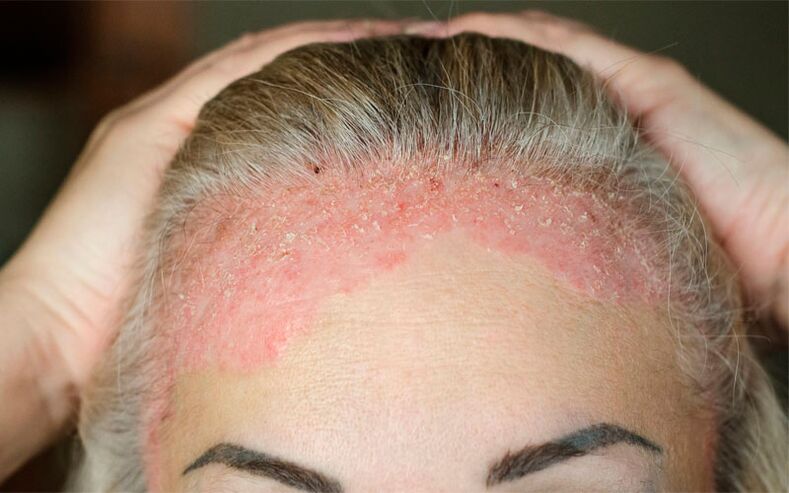
Psoriasis or psoriasis is a genetically determined skin pathology, which is based on a chronic recurrent inflammatory process of the skin (impaired maturation of keratinocytes) caused by the influence of stimulants. The localization of the rash is extremely multifaceted, the location of the foci of psoriasis can occur both in the mucosa of the mouth and on the scalp, the extensor surfaces of the limbs, nails or all over the body.
Since psoriasis is a systemic disease, the lesion will also be characteristic of the cardiovascular, nervous, muscular and other systems. In addition, the manifestation of the disease in 80% of cases in the initial stages is the loss of the head, so in this article we want to pay special attention to the specified localization of psoriasis.
Causes of psoriasis on the head
There are 2 types of psoriasis onset: early and late. Early species is genetically determined, heredity plays an important role here. It is known that the presence of the disease in one parent increases the risk of psoriasis in a child by 14%, and with psoriasis in both parents - by 40%.
There are more than 100 factors for the appearance of scaly lichen, the most common among them:
- genetics
- viral
- infectious (tonsillitis) and allergic
- stressful (psychosomatic)
- endocrine
- metabolic disorders (lipids, enzymes)
- immune disorders.
Symptoms of scalp psoriasis
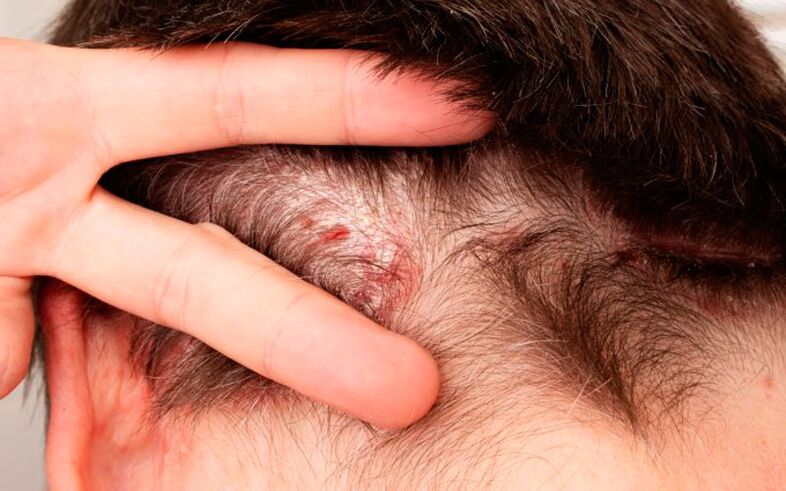
A characteristic element for psoriasis is a symmetrical flat height above the skin surface with evenly rounded borders and added roughness, combined with a large number of silver scales that are easily removed. The size of the rashes can vary from 1 mm to 2 cm, and for this reason the formations often come together and form plates with different configurations, which can reach 10 cm or even 20 cm.
A common occurrence in psoriasis is the so-called "psoriatic crown" - the passage of neoplasms into the smooth skin of the neck or temporary region along the hairline. A pronounced symptom that spreads to patients with scalp psoriasis is itching.
Psoriasis is defined by three main symptoms (psoriatic triad):
- "Stearin stain" - a psoriatic plaque scratched with a glass slide, as a result of which the scales become thinner, which increases the snow-white color of the surface and resembles a frozen stearin spot.
- "Terminal film" - with further scratching, a smooth translucent surface will be noticed.
- "Blood dew" - the presence of small drops of blood during scratching.
Stages of psoriasis development
The psoriatic process consists of 3 subsequent stages:
- I progressive
- II stationary
- III regressive
Progressive phase
It is characterized by the formation of new papules enlarged in diameter. The peeling process does not extend to healthy areas of the skin, while leaving a narrow pink stripe along the periphery of the plates. The main symptom among patients is itching. Also, for the progressive or acute stage of psoriasis, the presence of Koebner phenomenon is characteristic - the formation of new papules 7 days after skin damage. There is a psoriatic triad of symptoms.
stationary
At this stage, there is no appearance of new elements of redness, the manifestation of itching is reduced or disappears at all. Diagnosing the psoriatic triad is problematic, and Koebner's symptom is negative.
Regressive
In the regression phase, peeling decreases, plaques disappear, but hypopigmentation spots form. Psoriatic symptoms are not detected. It is worth noting that even after the regression phase, the "task plates" remain in the head, knee and elbow area.
Stages of the disease according to the degree of damage
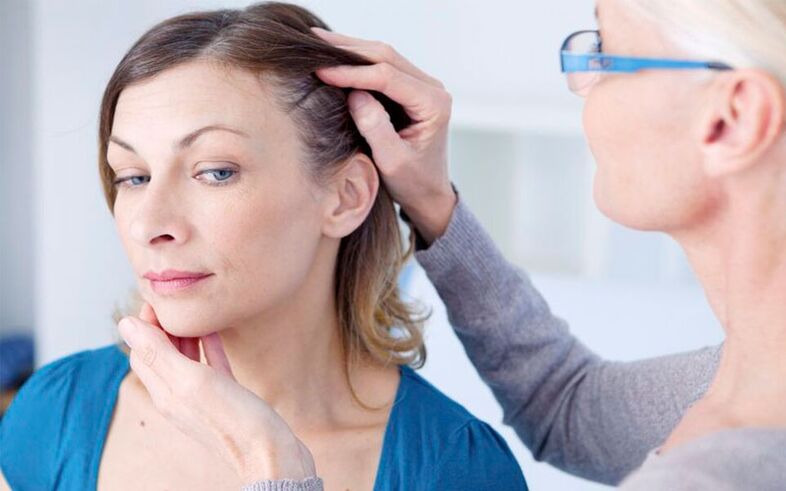
Depending on the area of the lesion, there are 3 stages of psoriasis:
- soft - the affected area is less than 3%
- moderate - the prevalence of papular rashes is from 3 to 10%
- severe - the lesions are localized to more than 10% of the skin.
How to cure psoriasis on the head
There are various methods of combined drug and non-drug treatment of psoriasis aimed at minimizing lesions, improving the patient's quality of life, and reducing the incidence of relapses.
Treatment of psoriasis depends on the extent of the skin lesions, the shape and age of the patient. If there are additional pathologies of organs and systems, they are corrected. Patients are prescribed a diet with a limited intake of salt, fatty and fast foods rich in carbohydrates.
Medical therapy
Effective tools for systemic psoriasis therapy are as follows:
- desensitizer (30% sodium thiosulfate solution),
- sedative (valerian infusion, sedative),
- antihistamine,
- diuretic,
- vitamins (A, B1, B12, B6, E, C),
- hepatoprotectors,
- pyrogenic preparations,
- immunostimulatory drugs,
In the common acute form of psoriasis, as well as in erythroderma, short-acting corticosteroids (triamcinalone) are prescribed.
With damage to the musculoskeletal system (joints), non-steroidal anti-inflammatory drugs (sodium diclofenac, voltaren, nimesulide) are indicated.
For the treatment of complicated forms of psoriasis, cytostatics (metatrexate, azathioprine) are used.
In severe forms of psoriasis (index greater than 15 units), cytostatics, sedatives, and aromatic retinoids are added to the therapy. In critical complicated episodes of scalp psoriasis, glucocorticosteroids are used.
In mild cases of psoriatic disease (PASI index up to 15 units), hyposensitizing, detoxifying and antihistamine drugs are used, as well as hepatoprotectants.
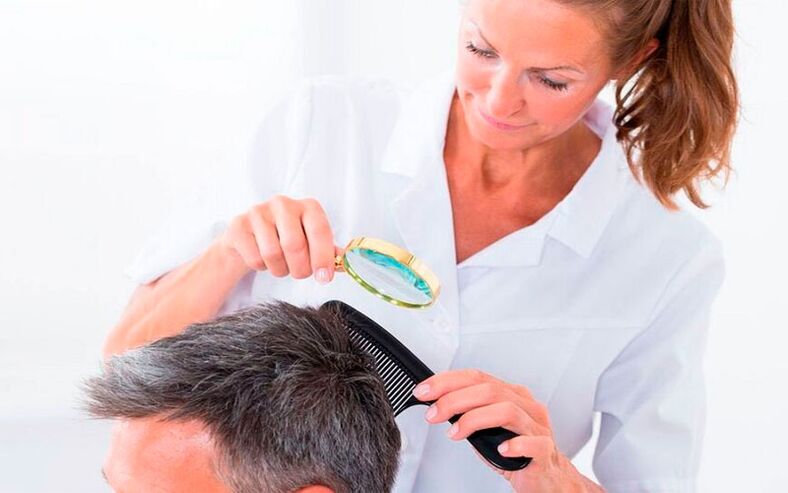
The use of topical treatment depends on the stage of scaly lichen:
- progressive - 1 - 2% salicylic ointment, creams and corticosteroid ointments
- stationary - 5 - 10% naphthalene ointment, 3% salicylic ointment, 2 - 5% sulfur-tar ointment, baths with chamomile decoction
- regressive - 3-5% salicylic ointment, 10-20% naphthalene ointment, 5-10% sulfur-tar ointment, psorkutan
Mercury-salicylic ointment, Psorix lotion and shampoo, tar balm, zinc preparations are widely known for scalp psoriasis. Also an integral part of the treatment of the disease are warm baths once in 2-3 days. In the winter form of psoriasis, therapy is based on the use of ointments in combination with ultraviolet radiation.
Non-drug treatment
Treatment of psoriasis is based not only on drugs. The use of phototherapy methods also contributes to a speedy recovery and the onset of remission.
There are the following types of radiation exposure:
- Photochemotherapy (PUVA therapy) is a type of phototherapy in combination with the use of photosensitizers. The mechanism lies in the action of ultraviolet radiation on the surface of the skin to treat complicated forms of psoriatic disease.
- Selective therapy is most effective in treating exudative and simple forms of psoriasis when there is a small number of rashes. The course of therapy consists of 20-30 sessions, the effectiveness is 80%.
- Narrow band therapy - used in the presence of superficial psoriasis, the rays do not penetrate deep into the skin balls, but have only a superficial effect. The procedure aims to prevent malignant cell degeneration processes.
- Narrow-spectrum UVB treatment - This type of therapy significantly reduces the appearance of side effects such as redness and burning. The course of the procedure is 20-30 sessions, used only for skin lesions.
Also, a positive impact comes from the treatment at the spa. Well-known sources of healing are Lake Kunigunda, the coast of Crimea, the Black Sea and the Dead.
Experimental Methods
Scientists do not stop and continue to look for new effective methods to treat psoriasis, among which are these.
Plasmapheresis
A gentle intoxication procedure that helps cleanse the blood plasma of pathogenic ingredients and toxins. After a procedure, as a rule, up to 30% of the blood is purified. This manipulation is used in severe and complicated cases of psoriasis. The plasmapheresis course is performed in 3-6 sessions, with a break for a week.
The mechanism of this procedure is as follows: certain membranes filter the intercellular fluid and return it to the bloodstream, while the beneficial ingredients are retained as much as possible and the pathogenic toxic substances are destroyed.
Cryotherapy or "cold treatment"
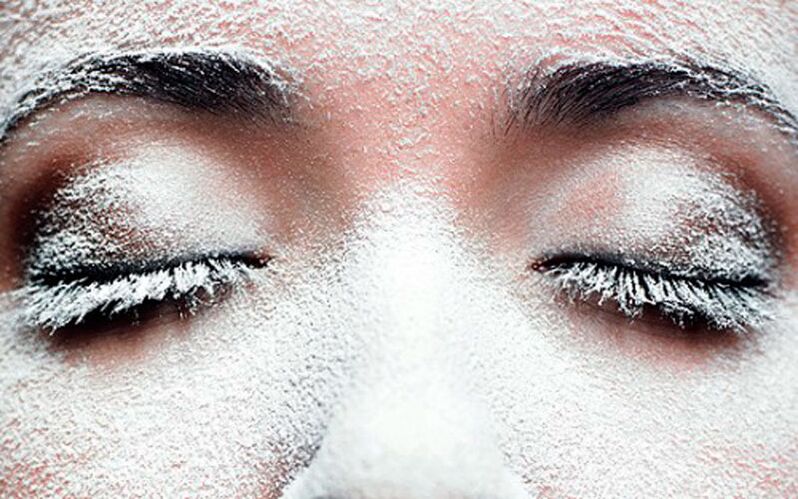
The therapy of the disease is due to the effect of ultra low rates on the body. The sharp effect of cold helps to activate the immune system and stimulate metabolism in general. This procedure has a complex effect on the whole body, and a local, which targets the focus of skin lesions.
It is important to keep in mind that cryotherapy is not suitable for all patients. Due to the anatomical features of the location of the vessels, some individuals experience spasm, swelling, and a sharp dilation of the vessels, as a result of which blood circulation is disturbed. In addition, some patients may be susceptible to allergic reactions such as cold urticaria.
The effect of cryotherapy:
- increase the body's defenses
- improved regeneration processes
- negative symptoms disappear: itching, burning, skin
- improves metabolism in the skin
- extension of periods of remission.
Immunobiological preparations
These are protein-based products that have a direct effect on the immune system and prevent the occurrence of concomitant diseases. In the presence of a psoriatic process, the body is constantly replenished due to an excessive amount of TNF protein. These drugs inhibit the effects of TNF, so the symptoms of the inflammatory process in psoriasis are reduced.
Ozone therapy
A new effective method for treating psoriasis. Ozone is known to have detoxifying, anti-inflammatory, antiplatelet, immunomodulatory effects. The advantages of ozone therapy are ease of use, rapid effectiveness, reliability and complete absence of side effects.
Characteristics of psoriasis treatment in children and adolescents
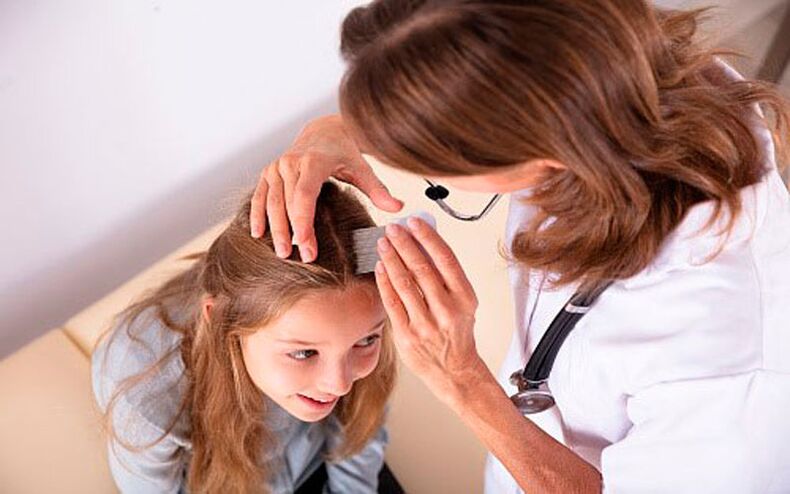
It should be noted that psoriatic disease is less common in children than in adults. The explanation is the low detection rate of psoriasis, the frequent common cases of regression, and significant remission periods of up to 12 years.
Features of the clinical picture of psoriasis in children are frequent skin lesions under the hair. Girls get sick 2 times more often than boys, which is associated with endocrinopathy that appear during adolescence. Children are characterized by a pronounced picture of the pathological process (significant inflammation and varying degrees of itching).
In children under 10 years of age, the manifestation of psoriasis symptoms differs from adults. The localization of the rash occurs in atypical places like the face, the back of the head, the genitals or the deep parts of the subcutaneous folds. The triggering mechanism for the onset of the disease is often an acute infection (influenza, pneumonia), psycho-emotional stress.
In most children, the first signs of lesions appear on the scalp and are accompanied by redness, scaling. Even in the most severe cases of scalp psoriasis, hair loss is not common.
Therapy for childhood psoriasis is based on the use of medicated ointments and creams; in severe episodes, a combination with other medications is used. This approach allows you to reduce the negative manifestation of the disease and contributes to a speedy recovery.
How to treat scalp psoriasis at home
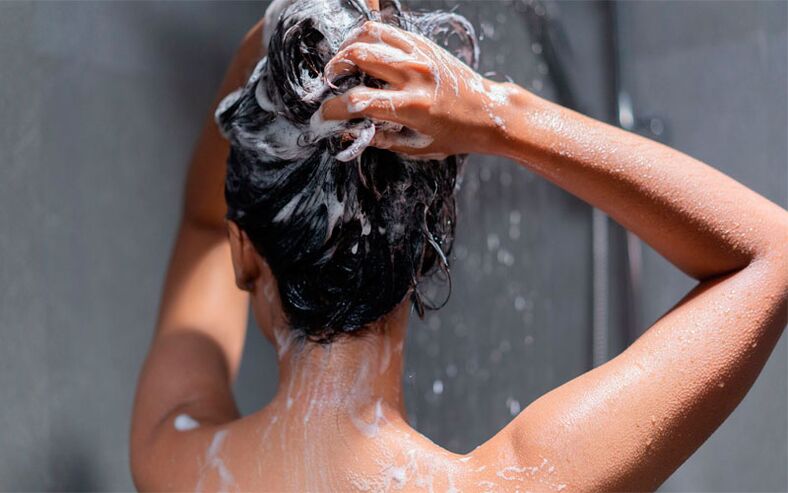
In the fight against dry scalp in psoriasis are used various base creams, lotions, herbal shampoos, water-based emulsions, which not only relieve skin inflammation, but also help alleviate the symptoms of psoriasis.
The most popular home remedies for psoriasis are creams, salicylic ointments and special shampoos.
Creams
Use non-hormonal agents based on natural ingredients. The active ingredients may be different, the most common of them:
- Zinc - quickly eliminates dryness and inflammation of the skin, has antiseptic properties, has an antibacterial effect
- Vitamin D - used to treat simple forms of psoriatic disease, relieves such unpleasant symptoms as skin and itching, and also helps improve regeneration
- urea and naphthalene - has a tonic and soothing effect on the skin
- Herbal extracts - have a disinfectant property, eliminate hypersensitivity and worsen the inflammatory process
- floralizin - promotes rapid healing, relieves unpleasant manifestations of psoriasis
- urea and beeswax - suitable for sensitive skin that needs hydration and nutrition, restores the protective barrier
Salicylic ointment in the fight against psoriasis
Salicylic acid, derived from willow bark, is the active ingredient in salicylic ointment and has anti-inflammatory and regenerative properties. The advantage of salicylic oil compared to hormonal medications is the lack of side effects.
Positive properties of salicylic oil:
- fights inflammation - removes itching and redness
- antiseptic action - eliminates pathogenic microorganisms
- Keratoplastic effect - prevents the appearance of purulent foci, promotes the regeneration process.
- destroys horny substance - exfoliates crusts.
Salicylic-zinc ointment is also widely used in the treatment of psoriasis and is no less effective.
Shampoo
There are the following types of shampoos for treating scalp psoriasis:
- Based on birch tar. Tar helps to gently cleanse the skin of the stratum corneum, impurities, eliminates itching and burning and has antifungal properties.
- Antifungal - the main active ingredient ketoconazole eliminates the reproduction of a fungal infection and promotes healing of skin wounds.
- It consists of salicylic acid, ketoconazole, zinc. This spray shampoo eliminates the inflammatory process, soothes the skin and has an antiseptic effect.
- Healing. Normalize the secretion of subcutaneous fat, strengthen hair, relieve inflammation.
It is also important to remember that when washing your hair with psoriasis, you should use only warm, not hot water. It is necessary to minimize the use of hair dryers, curls and ironing.
Treatment of psoriasis folk remedies
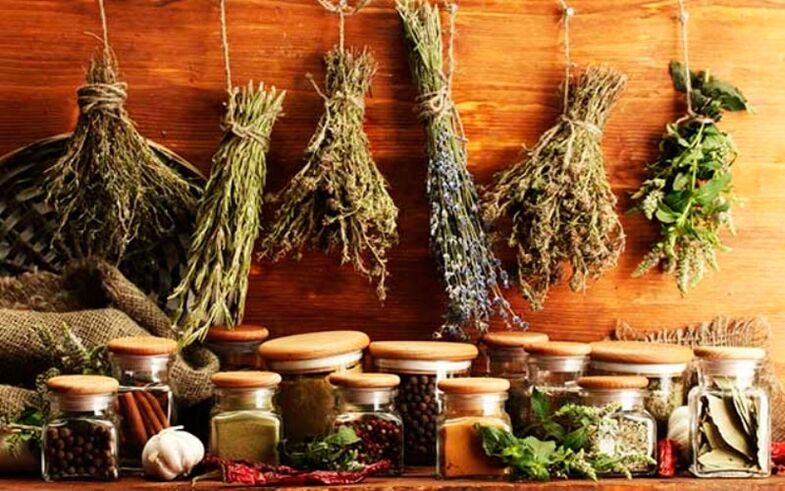
Lotions based on celandine, aloe vera, chamomile, apple cider vinegar are excellent for treating psoriasis. A wet bandage with a solution is applied to the lesions. This procedure reduces inflammation, kills pathogens and improves metabolism in the skin.
Also no less effective are kefir and mud masks, which also act as part of traditional medicine. Such masks also moisturize the hair, have an anti-inflammatory effect, improve blood circulation to the scalp.
Which product is better?
For the treatment of psoriasis of the head, it is better to use soft, gentle, fragrance-free products. Regular cleansing and hydration is the basis of proper hair and skin care for psoriasis. It is important that the products used help to normalize the balance of nutrients, restore the affected areas of the skin, maintain the pH of the scalp and hydrate the corneal layer of the epidermis.
All these effects and even more are characteristic for the products from the online store Fitomarket. Here you can choose not only the most appropriate high quality care tools and methods for scalp psoriasis, but also get the right advice on the medications that are right for you.
FAQ
Can psoriasis be treated with zinc ointment?
Zinc ointment has an anti-inflammatory, antiseptic, wrapping effect, promotes the formation of a protective layer on the surface of the skin. If you lubricate the affected areas daily with zinc ointment, then the positive effect will come quickly, but this medicine is not able to completely cure psoriasis, as the treatment must be complex.
Can you treat scalp psoriasis with hydrogen peroxide?
Hydrogen peroxide, releasing active oxygen, performs mechanical cleansing and eliminates toxic substances on damaged skin, but, as in the case of zinc ointment, will not work to cure scalp psoriasis with just this component.
Is psoriasis contagious?
Psoriasis is not transmitted because it is non-infectious in nature, so avoiding contact and communication with people with this disease is not worth it.
Is scalp psoriasis dangerous?
If left untreated, psoriasis can lead to serious complications and even death. Remember that psoriatic lesions can spread to the deeper layers of the skin, as well as to other organs and systems of the body (nails, cardiovascular system, musculoskeletal system, etc. ).
How to distinguish psoriasis from dermatitis
It is known that seborrheic dermatitis of the scalp never affects the smooth skin and is characterized by the absence of an infiltration process, in contrast to seborrheic psoriasis, which forms a "psoriatic crown", moving to smooth areas of the skin of the forehead and neck. . It is also worth mentioning the hereditary factor in the occurrence of psoriasis.























